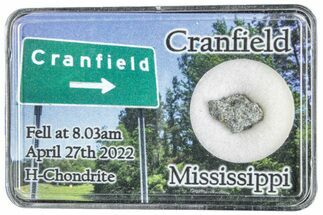1.30" Chondrite Meteorite (3.4 g) Slice - Taoussat-n-Amouzzour 001
This is a 1.30" wide (3.40 gram) slice of the L3 chondrite, Taoussat-n-Amouzzour 001. This is a fairly recent, potentially witnessed fall. It is a beautiful slice of the solar system's history, polished on one side to reveal its intricate interior details.
Comes in a bespoke acrylic display case.
Comes in a bespoke acrylic display case.
The Taoussat-n-Amouzzour 001 Chondrite Meteorite
Taoussat-n-Amouzzour 001 is the name given to multiple stones found by shepherds near a dry river bed, west of Massif de Taghouaji. At around 7 p.m. several days prior (December 15, 2022), local people at wadi Amdriga and the village of Tafragah, Niger observed a fireball east of Arlit. It's believed these discovered meteorites were from that fall.
All of the rocks show a fresh grayish interior with recognizable chondrules, and are partly to completely covered with black fusion crust.
Meteoritical Bulletin: Entry for Taoussat-n-Amouzzour 001
Taoussat-n-Amouzzour 001 is the name given to multiple stones found by shepherds near a dry river bed, west of Massif de Taghouaji. At around 7 p.m. several days prior (December 15, 2022), local people at wadi Amdriga and the village of Tafragah, Niger observed a fireball east of Arlit. It's believed these discovered meteorites were from that fall.
All of the rocks show a fresh grayish interior with recognizable chondrules, and are partly to completely covered with black fusion crust.
Meteoritical Bulletin: Entry for Taoussat-n-Amouzzour 001
About Chondrites
Chondrites are stony (non-metallic) meteorites that have not been modified by either melting or differentiation of the parent body. They are formed when various types of dust and small grains in the early Solar System accreted to form primitive asteroids. Some such bodies are captured in the planet’s gravity well and pulled to the surface. They are by far the most common type of meteorite, representing about 86 percent of all meteorites that have fallen to Earth.
Prominent among the components present in chondrites are the enigmatic chondrules, millimeter-sized spherical objects that originated as freely floating, molten or partially molten droplets in space; most chondrules are rich in the silicate minerals olivine and pyroxene. Chondrites also contain particles of various metals such as nickel, iron, and aluminum. These formed at the very beginning of the solar system and aggregated over time: they are the oldest rocks known on Earth!
Chondrites are divided into about fifteen distinct groups on the basis of their mineralogy, bulk chemical composition, and oxygen isotope compositions. The various chondrite groups likely originated on separate asteroids or groups of related asteroids. Each chondrite group has a distinctive mixture of chondrules, refractory inclusions, matrix (dust), characteristic chondrule sizes, and other components. Other ways of classifying chondrites include weathering and shock. The L chondrite group is the most common of these.
Chondrites are stony (non-metallic) meteorites that have not been modified by either melting or differentiation of the parent body. They are formed when various types of dust and small grains in the early Solar System accreted to form primitive asteroids. Some such bodies are captured in the planet’s gravity well and pulled to the surface. They are by far the most common type of meteorite, representing about 86 percent of all meteorites that have fallen to Earth.
Prominent among the components present in chondrites are the enigmatic chondrules, millimeter-sized spherical objects that originated as freely floating, molten or partially molten droplets in space; most chondrules are rich in the silicate minerals olivine and pyroxene. Chondrites also contain particles of various metals such as nickel, iron, and aluminum. These formed at the very beginning of the solar system and aggregated over time: they are the oldest rocks known on Earth!
Chondrites are divided into about fifteen distinct groups on the basis of their mineralogy, bulk chemical composition, and oxygen isotope compositions. The various chondrite groups likely originated on separate asteroids or groups of related asteroids. Each chondrite group has a distinctive mixture of chondrules, refractory inclusions, matrix (dust), characteristic chondrule sizes, and other components. Other ways of classifying chondrites include weathering and shock. The L chondrite group is the most common of these.
$42
TYPE
Ordinary Chondrite (L3)
LOCATION
Agadez, Niger
SIZE
1.30 x .77", .10" thick, 3.40 grams
CATEGORY
ITEM
#304567
 Reviews
Reviews









